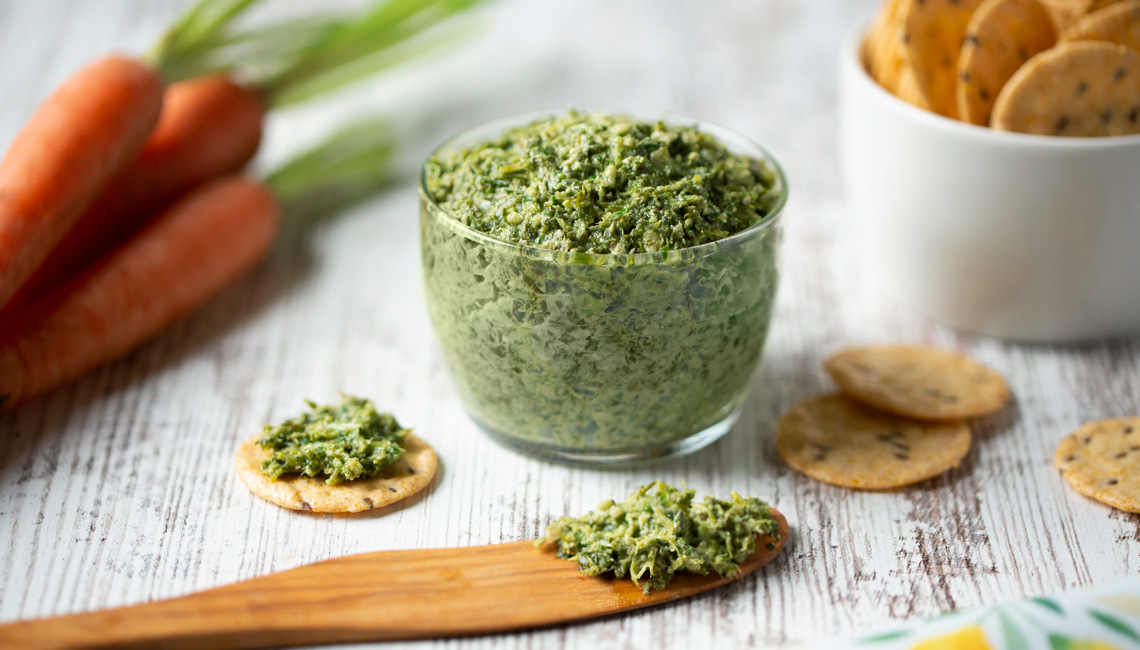
Heat oil in a large cast iron or nonstick skillet over medium-high heat. Add onion and sauté until soft and beginning to brown, 5 to 7 minutes. Add garlic, tomatoes with juice, broth, and smoked paprika. Bring to a boil. Add greens a handful or two at a time, stirring so they begin to wilt. Submerge Parmesan rind in the liquid. Reduce heat to medium-low, cover, and simmer about 5 minutes. Add beans and simmer 1 to 2 minutes to heat through. Divide among bowls; top with cheese, if desired. Eat solo or serve with Polish or Andouille sausage.
Per serving: 507 calories, 11 grams fat (4 grams saturated fat), 14 milligrams cholesterol, 699 milligrams sodium, 72 grams total carbohydrates, 29 grams fiber, 34 grams protein.
When it comes to edible greens, there are the usual suspects: collard greens, Swiss chard, mustard greens, and kale, for instance. But plenty of greens are edible that you might not expect; leaves from beets, turnips, radishes, sweet potatoes, and broccoli are delicious and nutritious. Use one type of green or mix and match multiple kinds. On top of using greens that might have otherwise been discarded, the extra hard rind at the end of your Parmesan wedge, which doesn’t slice or grate as easily as the rest, will infuse terrific flavor into the broth, and the rind becomes soft and scrumptious. Parmesan rinds can be stored in the freezer until ready to use.

In a medium pot, boil 5 or so cups of water. Roughly chop carrot-top greens and toss them in the boiling water for about 60 seconds, then immediately strain and rinse with cold water. (This mellows their slight bitterness.) Place all ingredients in a food processor. Pulse until finely chopped and beginning to form a paste, adding enough olive oil to loosen the pesto and make it scoopable. Serve hot or cold with raw or cooked vegetables, on crackers, atop carrot soup, or in pasta like a traditional pesto.
Per serving: 146 calories, 13.5 grams fat, 1.5 grams saturated fat, 0 milligrams cholesterol, 60 milligrams sodium, 5 grams total carbohydrates, 3 grams fiber, 4 grams protein.
Carrot greens (also called leaves and fronds) look a lot like parsley and taste a bit like it, too. Many herbs and greens can create a variety of pestos: arugula, parsley, basil, spinach, mint, kale, Swiss chard. With different combinations of nuts, cheeses, and oils, the possibilities are endless.

Preheat oven to 350 F. Grease 6 ramekins (or a 9 x 13-inch casserole dish) with some of the butter. Melt remaining butter. Spread bread cubes out on a cookie sheet and drizzle melted butter on top. Bake 10 to 15 minutes to toast bread. Let cool a few minutes.
In an extra-large bowl, whisk together eggs, milk, wine, and Worcestershire sauce. Stir in tomatoes, basil, oregano, rosemary, and half the cheese. Toss bread in milk mixture to coat. Using tongs, fill each ramekin (or casserole dish) with bread. Pour any leftover liquid in the middle of each ramekin. Bake until a golden-brown crust forms, 25 to 35 minutes. Top with remaining cheese and bake another 5 minutes, or until cheese has melted. Serve hot.
Per serving: 219 calories, 14.5 grams fat (8 grams saturated fat), 114 milligrams cholesterol, 258 milligrams sodium, 14 grams total carbohydrates, 1.5 grams fiber, 7 grams protein.
Do you have bread ends you don’t like eating? Half-eaten baguettes that are a bit too hard? Instead of discarding them, put leftover breads in a ziplock bag in the freezer. Once you’ve collected enough, you can make a variety of stuffings, croutons, breakfast casseroles, and bread puddings. Mix and match — French, Italian, white, wheat, even a bit of rye. Don’t be afraid to use up more ingredients from your fridge. Broccoli, green beans, kale, fresh herbs — it’s hard to go wrong. Along with leftover bread, this recipe is a good way to use up an excess of garden tomatoes (simply blanch, peel, and seed them) along with the last bit of a gallon of milk or bottle of wine.

Wash and lightly scrub the outsides of the oranges. Pat dry. Cut off ends, then slice the peel from end to end, sectioning it into quarters. Use your fingers to gently peel off each section.
Cut peels into thin, equally sized strips and place in a medium-sized pot. Fill pot with water until peels are covered. Top with a lid and bring to a boil. Continue boiling for another 5 minutes. Drain in a colander and repeat the boiling process with fresh water two more times to eliminate bitterness. After the third time, drain water and leave peels in colander for a few minutes.
In the same (now empty) pot, whisk together 2 cups sugar and 1¾ cups water. Turn burner to medium-high and cook until temperature reaches 230 F (10 to 15 minutes). Add the orange peels and continue to simmer on medium-low for 40 to 60 minutes. Check on the peels every 10 minutes or so, swirling the pot occasionally to ensure peels are covered with syrup. (Don’t stir, as stirring may cause crystallization.) When peels become translucent, remove pot from heat.
Pour the remaining cup of sugar into a shallow bowl. To give the candied peels a sour-candy kick, mix up to 1½ tablespoons citric acid into the sugar. Use a slotted spoon or tongs to remove a few of the peels at a time from the pot, letting excess syrup drip off for a few seconds. Toss peels in the sugar to coat, separating any pieces that stick together. Spread candied peels out on wire racks above cookie sheets. Continue process with the rest of the peels. When done coating, pour the remaining sugar into the pot with the leftover syrup, add a touch more water, and heat until sugar has dissolved. (Keep in mind that if you made them sour, you’ll have sour syrup!) Pour syrup into an airtight container and store in fridge for 2 to 3 weeks to use as an orange-infused simple syrup. Let peels continue to dry for 12 to 24 hours, until they are no longer sticky to the touch. Store in an airtight container for up to 1 month.
Per serving: 21 calories, 0 grams fat, 0 milligrams cholesterol, 0 milligrams sodium, 57 grams total carbohydrates, 1.5 grams fiber, 0.5 gram protein.
Note: Citric acid is a powder used for many things, including making sour candy. Find it in the canning supplies section.
This recipe is a great way to use orange peels before making orange juice, or, if you love eating oranges regularly, peel them in batches and store the fruit wedges to snack on later. This same recipe can be used to candy peels of 3 grapefruits or 6 lemons/limes. Grapefruit should simmer longer than the other fruits. Eat candied peels as is or use them on/in muffins, breads, cakes, and cocktails. A byproduct of making candied peels is a citrus-infused simple syrup to flavor beverages or drizzle over ice cream, pancakes, or snow cones.










